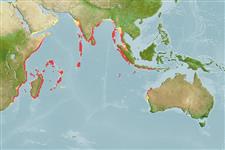>
Acanthuriformes (Surgeonfishes) >
Acanthuridae (Surgeonfishes, tangs, unicornfishes) > Acanthurinae
Etymology: Acanthurus: Greek, akantha = thorn + Greek, oura = tail (Ref. 45335).
Eponymy: Sir James Emerson Tennent (1804–1869) was a politician and traveller. [...] (Ref. 128868), visit book page.
More on author: Günther.
Environment: milieu / climate zone / Tiefenbereich / distribution range
Ökologie
seewasser riff-verbunden; tiefenbereich 1 - 40 m (Ref. 90102), usually 3 - 25 m (Ref. 27115). Tropical; 24°C - 28°C (Ref. 27115); 21°N - 30°S, 30°E - 116°E
Indian Ocean: East Africa to Sri Lanka and the Lesser Sunda Islands of southern Indonesia. The Red Sea record by Dor (1984, Ref. 2198) is an error.
Size / Gewicht / Alter
Geschlechtsreife: Lm ? range ? - ? cm
Max length : 31.0 cm TL Männchen/unbestimmt; (Ref. 3145); common length : 25.0 cm TL Männchen/unbestimmt; (Ref. 3146)
Rückenflossenstacheln (insgesamt) : 9; Rückenflossenweichstrahlen (insgesamt) : 23 - 24; Afterflossenstacheln: 3; Afterflossenweichstrahlen: 22 - 23. Brown in color, specimens up to 12 cm SL with black horseshoe mark on shoulder region breaking into 2 horizontal curved bands in larger specimens; caudal spine surrounded by a black area which is then surrounded by a bluish white area; caudal fin with a white posterior border (Ref. 3145).
Body shape (shape guide): short and / or deep; Cross section: compressed.
Inhabits lagoon and seaward reefs, 1 to over 20 m depth (Ref. 9710, 48637). Also found in slopes from silty inshore to outer reefs (Ref. 48637). Solitary or in groups (Ref. 90102). Sometimes occurs in small shoals. Grazes on benthic algae (Ref. 30573).
Life cycle and mating behavior
Geschlechtsreife | Fortpflanzung | Ablaichen | Eier | Fecundity | Larven
Randall, J.E., 1956. A revision of the surgeonfish genus Acanthurus. Pac. Sci. 10(2):159-235. (Ref. 1920)
IUCN Rote Liste Status (Ref. 130435: Version 2025-1)
Bedrohung für Menschen
Reports of ciguatera poisoning (Ref. 30298)
Nutzung durch Menschen
Fischereien: kommerziell; Aquarium: Kommerziell
Tools
Zusatzinformationen
Download XML
Internet Quellen
Estimates based on models
Preferred temperature (Ref.
123201): 24.7 - 29.1, mean 27.7 °C (based on 368 cells).
Phylogenetic diversity index (Ref.
82804): PD
50 = 0.5000 [Uniqueness, from 0.5 = low to 2.0 = high].
Bayesian length-weight: a=0.02344 (0.01118 - 0.04914), b=2.95 (2.78 - 3.12), in cm total length, based on LWR estimates for this Genus-body shape (Ref.
93245).
Trophic level (Ref.
69278): 2.0 ±0.00 se; based on food items.
Widerstandsfähigkeit (Ref.
120179): hoch, Verdopplung der Population dauert weniger als 15 Monate. (Preliminary K or Fecundity.).
Fishing Vulnerability (Ref.
59153): Low vulnerability (21 of 100).
🛈
Nutrients (Ref.
124155): Calcium = 61.2 [25.6, 175.5] mg/100g; Iron = 0.758 [0.290, 1.831] mg/100g; Protein = 18.2 [16.9, 19.4] %; Omega3 = 0.103 [0.048, 0.218] g/100g; Selenium = 18.1 [6.3, 53.5] μg/100g; VitaminA = 40.8 [9.3, 162.9] μg/100g; Zinc = 2.84 [0.90, 5.24] mg/100g (wet weight);
